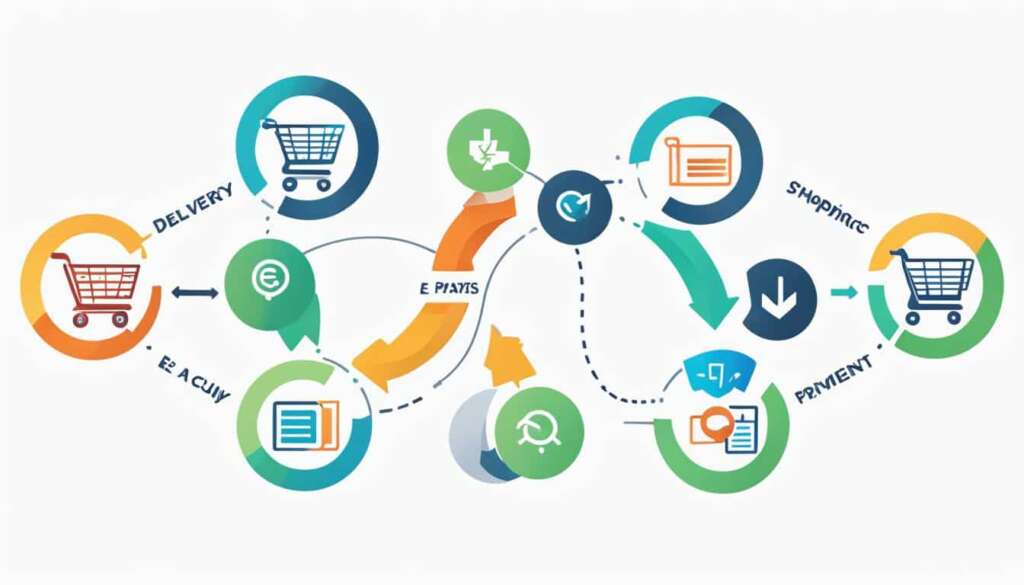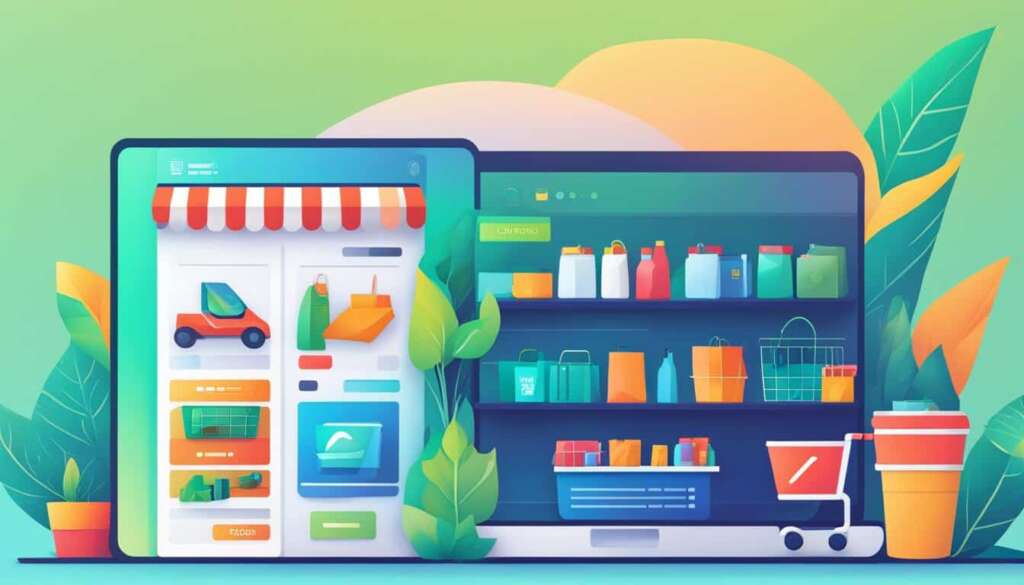Table of Contents
Welcome to our article on e-commerce, a defining concept in the world of online business. In this digital age, businesses and online markets continue to evolve, and e-commerce plays a crucial role in shaping the way we conduct business and interact with customers. So, let’s dive into the definition of e-commerce and explore how it impacts the business landscape.
E-commerce, short for electronic commerce, refers to the buying and selling of goods and services over the internet. It involves the transmission of funds and data through electronic networks, primarily the internet itself. This innovative approach allows businesses to connect with customers on a global scale, enabling transactions that were once limited by geographical boundaries.
- Business-to-Business (B2B): This involves the exchange of products, services, or information between businesses.
- Business-to-Consumer (B2C): Here, businesses sell products, services, or information directly to consumers.
- Consumer-to-Consumer (C2C): Customers engage in e-commerce by trading products, services, or information with each other.
- Consumer-to-Business (C2B): In this model, consumers offer their products or services for businesses to bid on and purchase.
The growth of e-commerce platforms like Amazon and eBay has revolutionized the retail industry. In 2011, e-commerce accounted for just 5% of total retail sales. However, as physical stores reopened, it has seen substantial growth, now representing approximately 15% of the market.
With e-commerce, customers can browse products, place orders, and complete transactions, all through the convenience of the internet. It allows businesses to reach customers around the clock and across borders, opening up vast opportunities for expansion and revenue generation.
Now that we’ve established the basics of e-commerce, let’s delve deeper into how it works in the next section.
How Does E-commerce Work?
E-commerce is a complex system that allows customers to browse and purchase products through online stores. Let’s take a closer look at how this process works:
1. Accessing Online Stores: Customers use their own devices, such as smartphones or computers, to access e-commerce websites through a web browser. They can browse through different categories, search for specific products, and view detailed descriptions and images.
2. Placing an Order: Once customers find the desired product, they can add it to their cart and proceed to the checkout process. During checkout, customers provide their personal information, shipping address, and payment details, such as credit card or PayPal information.
3. Web Browser Communication: After the customer clicks the “Place Order” button, their web browser communicates with the server hosting the e-commerce website. The order data is securely transmitted using encryption protocols to protect sensitive information.
4. Order Manager: The order data is then relayed to a central computer known as the order manager. This system plays a crucial role in processing the customer’s order. It handles tasks such as validating the order, updating inventory levels, and coordinating various processes.
5. Inventory Management: The order manager interacts with databases that manage inventory levels. It checks if the ordered products are available and updates the inventory accordingly. If a product is out of stock, the customer may be notified or given the option to backorder.
6. Payment Processing: The order manager also coordinates with payment processing applications and the customer’s bank to authorize the payment. It securely transfers the payment information, ensuring that sensitive data is handled safely and efficiently.
7. Order Validation and Notification: After the order is successfully validated and the payment is authorized, the order manager notifies the web server. The web server then displays a confirmation message to the customer, assuring them that their order has been received and is being processed.
8. Fulfillment and Dispatch: The order data is sent to the warehouse or fulfillment department, where tangible products are picked, packed, and prepared for shipping. For digital products or services, access is granted to the customer according to the terms of purchase.
9. Product Delivery: Tangible products are shipped to the customer’s provided address. The customer may receive shipping notifications and tracking information to monitor the progress of their delivery.
As you can see, e-commerce involves multiple components and processes working together seamlessly to provide a smooth online shopping experience for customers.
Types of E-commerce
E-commerce encompasses various business models that facilitate online transactions. Understanding the different types of e-commerce can help businesses align their strategies and better serve their target audience. The main categories of e-commerce include:
1. Business-to-Business (B2B) E-commerce
B2B e-commerce refers to the exchange of products, services, or information between businesses. This type of e-commerce plays a crucial role in supply chain management, enabling companies to streamline procurement processes, collaborate with suppliers, and negotiate better prices. B2B transactions often involve large quantities or high-value products, catering to the specific needs of other businesses.
2. Business-to-Consumer (B2C) E-commerce
B2C e-commerce involves businesses selling products, services, or information directly to consumers. This is the most common and well-known type of e-commerce, as it encompasses online retail platforms like Amazon, eBay, and Shopify. B2C transactions typically feature a wide range of products that cater to individual consumers, providing convenience and accessibility for online shoppers.
3. Consumer-to-Consumer (C2C) E-commerce
C2C e-commerce enables consumers to trade products, services, or information with each other through online platforms. Websites like eBay, Etsy, and Craigslist facilitate C2C transactions by connecting individual buyers and sellers. This type of e-commerce creates an online marketplace where consumers can engage in peer-to-peer transactions, facilitating the exchange of used items, handmade crafts, or services.
4. Consumer-to-Business (C2B) E-commerce
C2B e-commerce involves consumers making their products or services available for businesses to bid on and purchase. This type of e-commerce is prevalent in the gig economy, where freelancers and independent contractors offer their skills and expertise to businesses in need. Platforms like Upwork and Fiverr connect consumers with companies seeking specific services, enabling flexible work arrangements.
5. Other Types of E-commerce
In addition to the main categories mentioned above, e-commerce also includes business-to-administration (B2A) and consumer-to-administration (C2A) transactions. B2A e-commerce refers to transactions conducted between businesses or consumers and government bodies. Examples include online tax filing, license renewal, and online government services. C2A e-commerce involves individuals purchasing products or services from government entities, such as paying utility bills or accessing public services online.
Understanding the various types of e-commerce allows businesses to tailor their strategies to meet the needs of their target market. By choosing the right e-commerce model, businesses can optimize their online presence, enhance customer experiences, and drive growth in the digital era.

| E-commerce Type | Description |
|---|---|
| Business-to-Business (B2B) | Exchange of products, services, or information between businesses. |
| Business-to-Consumer (B2C) | Businesses sell products, services, or information directly to consumers. |
| Consumer-to-Consumer (C2C) | Consumers trade products, services, or information with each other. |
| Consumer-to-Business (C2B) | Consumers offer their products or services for businesses to bid on and purchase. |
| Business-to-Administration (B2A) | Transactions between businesses or consumers and government bodies. |
| Consumer-to-Administration (C2A) | Individuals purchasing products or services from government entities. |
Advantages of E-commerce
E-commerce, with its numerous advantages, revolutionizes the way businesses operate in today’s digital era. Let’s explore the key benefits that make e-commerce an indispensable tool for entrepreneurs and consumers alike.
1. 24/7 Availability
One of the standout advantages of e-commerce is its round-the-clock availability. Unlike physical stores with fixed operating hours, e-commerce platforms allow customers to browse and shop at any time, ensuring convenience and flexibility.
2. Speed of Access
E-commerce platforms prioritize speed, ensuring a seamless and efficient shopping experience. Product, shopping cart, and checkout pages load swiftly, reducing waiting times for customers. With just a few clicks, transactions are swiftly completed, saving valuable time for both buyers and sellers.
3. Wide Selection of Goods
Online platforms offer an incredible array of products compared to traditional retail outlets. E-commerce stores can stock a vast inventory, ensuring customers have access to a wide variety of goods. Whether it’s clothing, electronics, or beauty products, e-commerce platforms cater to diverse consumer needs and preferences.
4. Easy Accessibility
Finding products quickly is a breeze with the intuitive search features and organized product category pages of e-commerce platforms. Customers can easily navigate through the vast selection, filtering and refining their search until they find the perfect item. This accessibility enhances the overall user experience and increases customer satisfaction.
5. International Reach
E-commerce transcends geographical boundaries, providing businesses with an unparalleled opportunity for international expansion. With e-commerce, businesses can reach customers across the globe, tapping into new markets and expanding their customer base. This global reach enables businesses to maximize their growth and increase revenue potential.
In summary, e-commerce offers numerous advantages, including 24/7 availability, speed of access, a wide selection of goods, easy accessibility, and international reach. These benefits empower both businesses and consumers, making e-commerce a game-changer in the world of online shopping.
Disadvantages of E-commerce
E-commerce, despite its numerous advantages, also presents some drawbacks that customers and businesses should be aware of. These disadvantages include limitations in customer service, challenges in product experience, potential delays in shipping, and security concerns.
Limited Customer Service
One of the main disadvantages of e-commerce is the limited availability of customer service. Online support may have restricted hours of operation, making it difficult for customers to seek assistance or resolve inquiries outside of those hours. This can be frustrating, especially when customers have urgent questions or require immediate assistance.
Product Experience
Another disadvantage is the lack of physical interaction with products before purchase. Unlike traditional brick-and-mortar stores, customers cannot touch or try products before making a buying decision. This can create potential mismatches between customers’ expectations and the reality of the product they receive. Although product descriptions and images may provide some insight, the absence of direct tactile and sensory experience can pose a challenge.
Wait Time for Shipping
When shopping online, customers often have to wait for their products to be shipped and delivered. Although efforts are being made to reduce shipping windows, delays can still occur due to various factors such as inventory availability, logistical challenges, and unforeseen circumstances. In situations where customers require immediate access to a product, longer wait times can be frustrating and inconvenient.
Security Concerns
Security is another prominent concern in e-commerce. With the increasing sophistication of hackers, there is a constant risk of falling victim to fraudulent schemes. Hackers can create authentic-looking websites to deceive customers into providing their personal and financial information. This poses a significant threat to the security and privacy of both customers and businesses.
| Disadvantages | Impacts |
|---|---|
| Limited customer service | Difficulties in seeking assistance and resolving inquiries outside of operating hours |
| Product experience | Potential mismatch between customers’ expectations and the reality of the purchased product |
| Wait time for shipping | Frustration and inconvenience due to delays in product delivery |
| Security concerns | Risk of falling victim to fraudulent schemes and compromising personal and financial information |

Conclusion
In conclusion, e-commerce plays a crucial role in the modern business landscape, providing businesses with the opportunity to reach a global customer base and sell products and services online. The advantages of e-commerce are significant, offering businesses 24/7 availability, easy accessibility, fast speed of access, a wide selection of goods, and the ability to expand their reach internationally. By embracing e-commerce, businesses can tap into the growing trend of online shopping and capitalize on the convenience it offers to customers.
However, it is important to acknowledge the disadvantages of e-commerce as well. Limited customer service can be a challenge, as online support may not be available at all times to address customer queries and concerns. Additionally, customers may miss the ability to touch and experience products before making a purchase, leading to potential dissatisfaction. Shipping wait times can also be a drawback, although efforts are being made to minimize delivery windows.
Security concerns are another aspect to consider when engaging in e-commerce. Customers need to be cautious of fraudulent websites and ensure that their personal and payment information is protected. Implementing robust security measures is crucial to maintaining customer trust and safeguarding sensitive data.
Despite these challenges, e-commerce continues to evolve and transform the way people shop and conduct business online. As technology advances and customer expectations change, businesses must adapt and leverage the advantages of e-commerce while addressing its limitations. By understanding the advantages and disadvantages of e-commerce, businesses can make informed decisions to optimize their online presence and enhance the overall online shopping experience.
FAQ
What is e-commerce?
E-commerce, also known as electronic commerce, is the buying and selling of goods and services over the internet.
How does e-commerce work?
E-commerce works by customers using their own devices to access online stores, where they can browse products and place orders. When an order is placed, the customer’s web browser communicates with the server hosting the e-commerce website. The order data is then relayed to a central computer known as the order manager, which sends the data to databases managing inventory levels, payment processing applications, and the bank. After validation of the order, the order manager notifies the web server, which displays a message to the customer. The order data is also sent to the warehouse or fulfillment department for product dispatch. Tangible and digital products are then sent to the customer, or access to a service is granted.
What are the types of e-commerce?
The main types of e-commerce business models include business-to-business (B2B), business-to-consumer (B2C), consumer-to-consumer (C2C), and consumer-to-business (C2B). Other types of e-commerce include business-to-administration (B2A) and consumer-to-administration (C2A), where transactions are conducted between businesses/consumers and government bodies.
What are the advantages of e-commerce?
E-commerce offers several advantages, including 24/7 availability for customers to browse and shop online, speed of access, a wide selection of products, easy accessibility to find products quickly, and the ability to reach a global customer base.
What are the disadvantages of e-commerce?
Some of the disadvantages of e-commerce include limited customer service, the inability to touch and experience products before purchasing, wait times for shipping, and security concerns.













